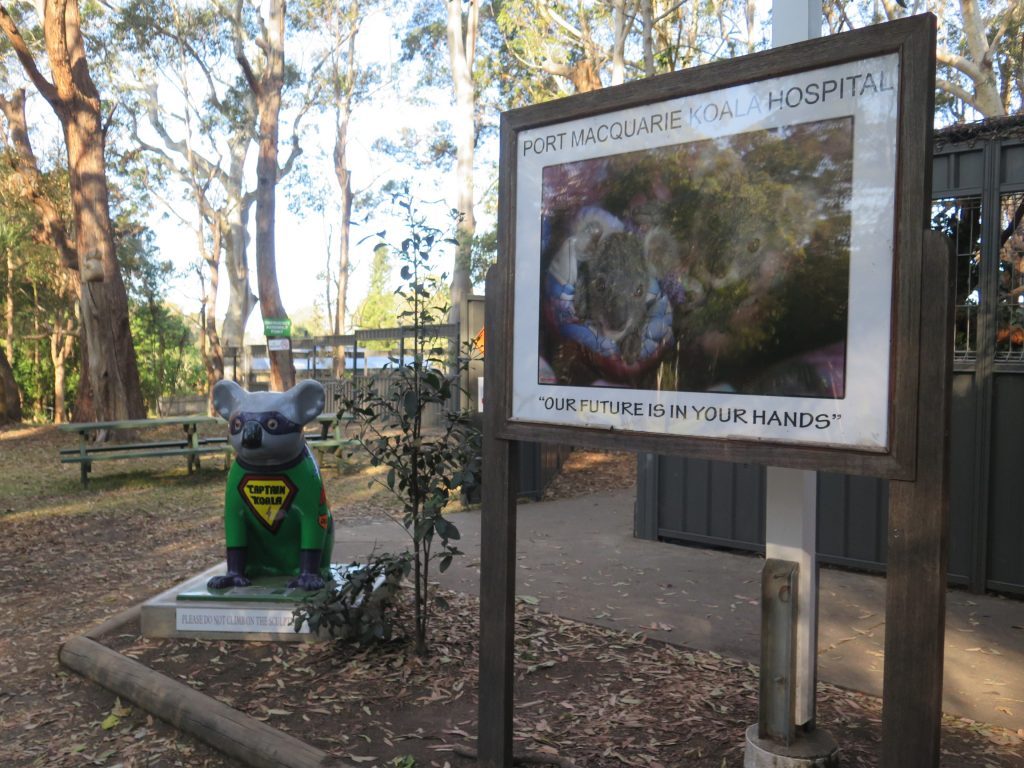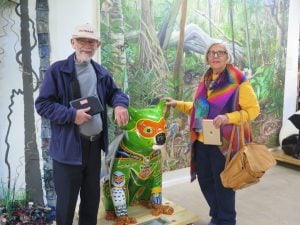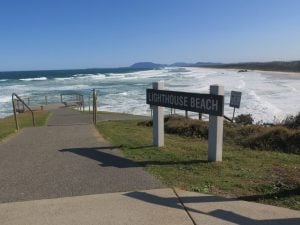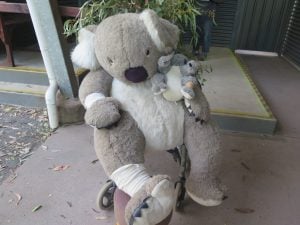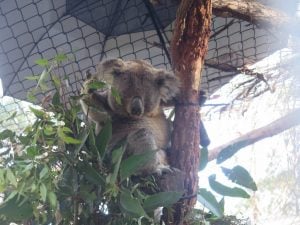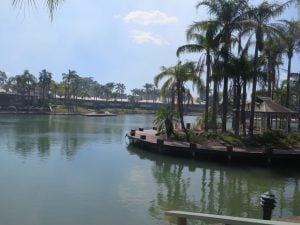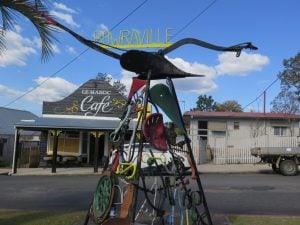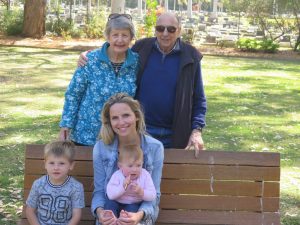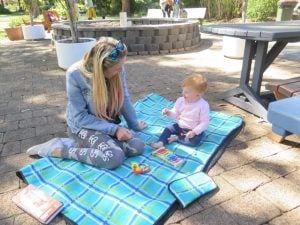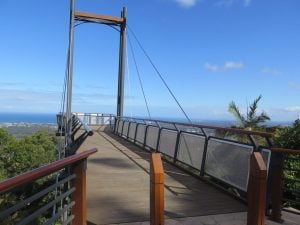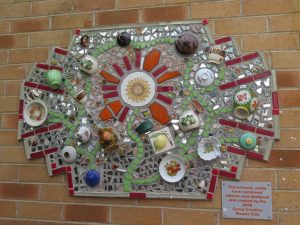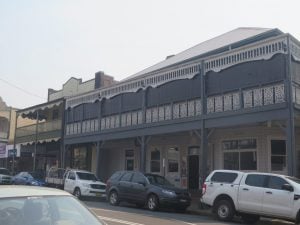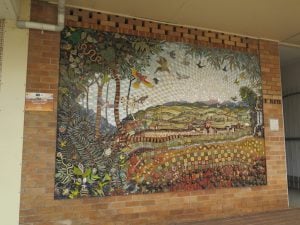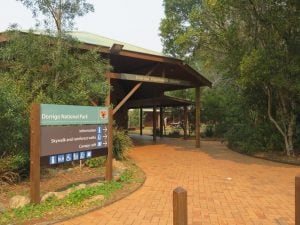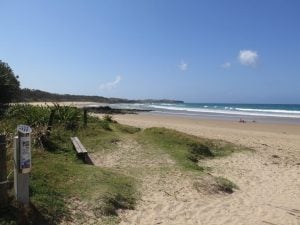Click on images to enlarge
7 September 2019
My cousin Sandra and her husband Trevor from Canberra have invited me to spend a few days with them at the Ultiqa Resort at Port Macquarie, and I was very happy to accept their kind offer. They stayed over at my home last night, and this morning we are travelling in tandem heading for the Resort for a few days, then I will be heading further north to Sawtell.
We left Newcastle after breakfast at about 9.30am, planning to stop at the Cherry Pie Cafe at Coolongolook for morning tea. We had all at some time stopped at the Cherry Pie Cafe and were not disappointed with the slice of cherry pie that we had with a coffee, then driving on to Port Macquarie. Trevor’s brother and sister-in-law were also staying at the Resort with us, and we had arranged to meet them at the main shopping centre for lunch. We are not able to check in to the Resort until 4pm so we had time to find a nice alfresco cafe (Drury Lane Eatery) outside one of the shopping malls and enjoyed a delicious lunch in the plaza, sheltered from the cooler weather and the strong wind. We decided to check out one of the supermarkets to buy some food to last us over the first couple of days (including a tasty quiche and salads for dinner), and by this time were ready for the 4pm check in at the Ultiqa Resort.
The accommodation was very comfortable with 3 bedrooms, two bathrooms and a spacious living/kitchen area, and set in beautiful grounds with lots of palm trees and colourful shrubs that had started their spring flowering. Lots of conversation, laughter and catching up on news during the evening.
8 September, 2019
Today is quite cool, and the strong wind persists, but that did not stop us from exploring Port Macquarie. Quite close to the Resort we came across the Arts and Crafts Market with lots of stalls selling plants including some fantastic succulents (so easy to grow), jewellery, pickles and preserves, and the Art Gallery with works from local artists. It was a lot of fun especially listening to a busker playing music of our era, couldn’t help dancing along with the familiar tunes!
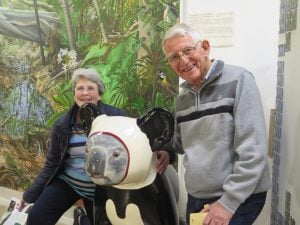 We spent more time than we planned at the markets and were starting to get hungry, so we made our way to our next visit at the Sea Acres National Park, a short distance south of the town centre. First we had lunch and a coffee, then had a chance to have a look at the souvenir shop before we headed for the walk around the boardwalk in the rainforest area. It was beautiful walking through the rainforest as we had lots of protection from the wind, but the area was quite dry due to lack of rain. We loved meeting the Hello Koalas (above) that are dotted around the rainforest (and around Port Macquarie generally), they are so colourful and cute.
We spent more time than we planned at the markets and were starting to get hungry, so we made our way to our next visit at the Sea Acres National Park, a short distance south of the town centre. First we had lunch and a coffee, then had a chance to have a look at the souvenir shop before we headed for the walk around the boardwalk in the rainforest area. It was beautiful walking through the rainforest as we had lots of protection from the wind, but the area was quite dry due to lack of rain. We loved meeting the Hello Koalas (above) that are dotted around the rainforest (and around Port Macquarie generally), they are so colourful and cute.
Pat and Graham (above left) and Sandra and Trevor (below right) make friends with the koalas.
Some information about Sea Acres National Park – The Sea Acres National Park is located in the Mid North Coast region of New South Wales. The 76-hectare (190-acre) park is situated near the town of Port Macquarie and is a popular tourist area with a 1.3-kilometre (0.81 mi) long boardwalk through a remnant of seaside rainforest. There is also an education centre and cafe. The park was initially declared as a nature reserve in 1987 and gazetted as a national park in October 2010.
Recorded within the reserve are over a hundred types of bird species. Rare species include the wompoo fruit dove, rose-crowned fruit dove and osprey. Reptiles include the lace monitor, land mullet, and the diamond python. Twenty one species of mammals have been recorded in the national park, including koala, spotted-tail quoll and the little bent-wing bat. Two rare types of snail are known here.
The Park contains one of the largest and most intact segments of coastal rainforest in New South Wales. The remnant rainforest area adjacent to Shelley Beach is noteworthy as much of this sea side type of forest has been cleared for agriculture, mining or housing. Common species of tree include tuckeroo, coogara, red olive berry, white walnut, flintwood, strangler fig (above left,and right), sour cherry, Francis watergum, maiden’s blush and mock olive. Vines are common and include the lawyer vine, supplejack and water vine. Walking stick palms and Bangalow palms are often seen. Epiphytes are common in the taller more protected areas such as the staghorn and elkhorn ferns. The hares’ foot fern is an interesting climbing plant in the rainforest.
There are also non-rainforest areas which include grassland, banksia woodland and eucalyptus forest with tallowwood, blackbutt and Sydney blue gum. Below left is the outdoor education centre within the park.
The Hello Koalas Sculpture Trail is open every day of the year and is completely free! It features over 70 individually designed one-metre high Hello Koala sculptures waiting for you to discover across the Port Macquarie district. Lovingly hand-painted or mosaiced by talented Australian artists, every Hello Koala features environmental, wellbeing, heritage or cultural designs to fall in love with and get you thinking and talking.
The award-winning Hello Koalas Sculpture Trail provides fun and entertaining day(s) out for people of all ages, perfect for families to enjoy together. It is also a unique and creative way to raise awareness of the importance of protecting our koalas and our environment. Port Macquarie is lucky to have one of the largest Koala populations on Australia’s east coast. But this Aussie icon is endangered everywhere by land clearing for roads and houses, by vehicle strikes, dog attacks, climate change and disease.
We thoroughly enjoyed our walk through the rain forest, and particularly meeting up with some of the Hello Koalas!
Next visit was to Tacking Point Lighthouse. It was blowing a gale as the lighthouse of course is in a very exposed area overlooking Lighthouse Beach and the vast ocean. Close to the lower lookout we were covered with sea spray, and could see the waves smashing into the rocks.
Some history of Tacking Point Lighthouse – In the early to mid 19th Century the main contact for the coastal towns of the north coast of New South Wales was sea transport. There were no roads and the railways were only just beginning. There were few lights and in the Tacking Point area more than 20 wrecks occurred, the first being the schooner Black Joe in 1823, and the steamer Sumatra in the same year. In 1879 a fixed catadioptric light of less than 1000 candelas was erected on Tacking Point. The structure is built of cement-rendered bricks and because of the elevation only needed to be 8 metres high.
The apparatus was converted from wick oil light in 1919 to automatic acetylene operation. The light was then converted to mains electricity in 1974. As a result of automation the keepers were withdrawn after 40 years of service. The foundations of the keeper’s cottage can still be seen (below right).
Built in 1879 by NSW architect James Barnet, Tacking Point Lighthouse is the thirteenth oldest lighthouse in Australia. Due to the elevation of the rocky headland, the lighthouse itself is only eight metres high, and the area itself is a popular location for whale-watching during migration. The area referred to as Tacking Point is the headland upon which the Lighthouse is and was originally named in 1802 by Matthew Flinders as he sailed his ship “Investigator” close to the headland, a few miles south of the river mouth, then tacked and headed south again.
We were keen to have time to see the Koala Hospital that focuses on preservation and conservation. We arrived at about 3pm which is feeding time so were able to join the tour with a very knowledgeable guide who explained why each koala was in the hospital, and how they were being treated before being released into the wild.
The Koala Hospital, established in 1973, is an activity of the Koala Conservation Australia Incorporated – a Not-for-Profit Organisation which is recognised world-wide as a peak body which participates in forums for debate on significant policy issues and plays a significant leadership role in research, providing advice and information to Universities and Governments regulating change.The Hospital consists of a treatment room, 8 Intensive Care Units, 6 outdoor intensive care units and 33 rehabilitation yards, many of which have trees for koalas to learn to climb as part of the rehabilitation process.
- It is not only a Hospital to treat sick and injured koalas but it is also involved in research with University Sydney, University Technology Queensland and the Australian Museum into koala diseases.
- Between 200 and 250 koalas are admitted through the Hospital annually.
- Apart from Chlamydia, motor vehicle accidents and dog attacks are the most common cause of injuries sustained, predominantly during the breeding season.
Friendly Barrington Xavier is recovering in the Koala Hospital
Our last visit for the day was to to Roto House which is adjacent to the Koala Hospital. From the moment you pass the picket fence and enter the bull-nosed verandah of Roto House, it feels as though you’ve stepped back in time. Entering the front door flanked by ruby lights, there is a grand hallway decorated with cast iron lamps suspended from the ceiling.
Built in 1890, Roto House was home to John Flynn, a land surveyor, his wife Jessie and six children. This 11 room weatherboard house constructed from local red mahogany was occupied by his family right up until 1979. It’s still lovingly maintained by the National Parks and Wildlife Service to this day. Many of the family’s belongings, papers and photographs are preserved and displayed throughout the house.
It is amazing to walk through this beautiful old house, and its surrounding gardens, and imagine how life would have been for the Flynn family.
We had decided to cook a chicken stir fry for dinner tonight, so a quick visit to the supermarket on the way back to the Resort for some additional ingredients! Team effort to prepare dinner – stir fry was delicious!
9 September 2019
 The weather today is still wild and quite cool, we were a bit slower getting going and I was wishing I had brought more warm clothes! We explored the resort which included a Club House, a large lake with an island, lots of kayaks, a couple of tennis courts, and an indoor swimming pool. Earlier we had noticed some men who were trimming the very tall palm trees (no doubt for safety reasons as it could be very dangerous to have a large clump of nuts hitting you on the head). We had a chance to talk to the young man who was climbing up the trees (right), and he explained how it was done – very brave! No doubt they are getting the resort ready for the summer visitors.
The weather today is still wild and quite cool, we were a bit slower getting going and I was wishing I had brought more warm clothes! We explored the resort which included a Club House, a large lake with an island, lots of kayaks, a couple of tennis courts, and an indoor swimming pool. Earlier we had noticed some men who were trimming the very tall palm trees (no doubt for safety reasons as it could be very dangerous to have a large clump of nuts hitting you on the head). We had a chance to talk to the young man who was climbing up the trees (right), and he explained how it was done – very brave! No doubt they are getting the resort ready for the summer visitors.
We decided to have coffee at the Rivermark Cafe that fronts on to the Hastings River, with lovely views and some protection from the persistent wind. I was getting ready to drive a few hours north to Sawtell so decided to make this my lunch and had a tasty wrap with coffee, time to relax and enjoy the view.
It was then time for me to leave my friends and beautiful Port Macquarie and set off further north to Sawtell to meet up with my Queensland friend Pete.
By sheer coincidence we arrived at the same time, so had a chance for a nice walk around the main shopping area with its beautiful central garden including giant fig trees and shrubs, and to have a coffee. After unpacking and settling in to the apartment we had dinner at the Sawtell Hotel, a short walk from our apartment, and planned our sightseeing for the rest of the week.
10 September 2019
This morning we plan to explore the area around Nambucca Heads, after having breakast at Split Cafe in the Sawtell main street (best Bircher Muesli I’ve ever had). It was a very pleasant drive along the highway, then in to hilly Nambucca. The name Nambucca is derived from the Aboriginal word meaning ‘entrance to waters’. Firstly we had a short walk along the Nambucca River, then found the Information Centre to gather some pamphlets of the sites we wanted to visit. There was still a strong wind, and most of the places we visited were at ocean lookouts, so we didn’t spend an extended time there, just time to take in the view and get some photographs!
Our first stop was to see the V Wall which extends along the area where the Nambucca River meets the sea. Large boulders and rocks form the wall along which locals and visitors have painted messages and images (below left and right), similar to that at Port Macquarie.
Next was the Rotary Lookout with fabulous views over the Nambucca River entrance and beyond to the south.
For sweeping views of Nambucca beaches and beyond, the Captain Cook Lookout above pretty Shelly Beach is a great vantage point for whale watching when majestic humpback whales migrate along the coast between May and November. We didn’t see any whales but the view from Captain Cook Lookout (below left and right) was quite special, despite the wind!
The wind was becoming quite unpleasant so we decided to leave beautiful Nambucca Heads and continue on to Bowraville where we hoped to be able to see the Frank Patridge VC Military Museum. Bowraville is a very sleepy little town, but the museum was open and we were made very welcome by the volunteers who man the museum. It was interesting to find out more about our gentle Victoria Cross recipient, Frank Patridge, and it brought back memories of him and his great success on Bob Dyer’s quiz show that seems like many years ago.
We spent quite a long time there, it is very well set out, with different rooms showing memorabilia from WW1, WW2, the Korean, Vietnam and Afghanistan wars etc, it is one of the best displays I have seen outside the National War Memorial, and the locals are rightly very proud of it.
Although we were willing to spend some money in this quaint little town, we could not find a cafe that was open, so we walked up and down the main street, got in the car, and headed back to Sawtell for afternoon tea!
A link to the Military Museum website here
11 September 2019
We had breakfast at the apartment this morning, then had arranged to meet up at the Coffs Harbour Botanical Gardens with my friend Emily, her son Reign who is almost 4, and her almost one year old daughter River. Fortunately the wind had eased and the sun was shining, and we found Emily where she had set up a rug for the children next to a table in the open air cafe for us.
The children were a delight, Reign found lots to do with a large stick and the model cars we had bought for him, and River liked playing with her little xylophone, she is a very happy and contented child. Pete obviously enjoyed his time playing “grandfather” and spent a lot of time with the children. It was great to catch up with Emily and hear all her news.
We had heard about the Forest Sky Pier at the Sealy Lookout which is just north of Coffs Harbour, so after saying our goodbyes to Emily and the children we set off to find the steep road up to the lookout. The views are certainly spectacular, and stretch from Coffs Harbour, down to Sawtell and beyond.
Located on an escarpment 310 metres above Coffs Harbour and only 9km from the city centre, the Forest Sky Pier projects 21.6 metres beyond the original lookout and offers an expansive vista encompassing Coffs Harbour city, its foreshore and marina, Solitary Islands Marine Park, surrounding mountain ranges and the coastline far into the distance. On a clear day you can see 100km to the south.
Adjacent to the Forest Sky Pier, a fully-accessible picnic shelter is available for those wishing to sit, have a cuppa and enjoy the view.
We certainly enjoyed the view (cameras were clicking) and walking around the area.
The only problem we had was getting back on to the main road to return to Sawtell at a time when the peak hour traffic was starting, but after heading north for a while we found a U-turn and were able to then head south again. We decided to have dinner at the RSL Club which was a short walk from the apartment, and were amazed at the change in the building since we were there last, about 3 years ago. It is now a massive building, huge dining room – however I was not over impressed with my lamb shank and vegetables – much too noisy too! Must be getting old!
12 September 2019
 This morning we decided to have an early walk along the beach, we noticed there was a lot of smoke over the ocean, which we found out was coming from several fires outside the township of Dorrigo. There is a great kiosk at Sawtell beach and we enjoyed breakfast there, then we set out for our planned drive to the Dorrigo National Park. There had been no road closures due to the fires, so we felt safe heading in that direction along Waterfall Way (which eventually takes you to Armidale).
This morning we decided to have an early walk along the beach, we noticed there was a lot of smoke over the ocean, which we found out was coming from several fires outside the township of Dorrigo. There is a great kiosk at Sawtell beach and we enjoyed breakfast there, then we set out for our planned drive to the Dorrigo National Park. There had been no road closures due to the fires, so we felt safe heading in that direction along Waterfall Way (which eventually takes you to Armidale).
The lovely town of Bellingen was on our way (a fair amount of smoke in the air), and we stopped there for a walk around the main street, then morning tea. My attention was drawn to the colourful mosaic (left). I really love the rural townships with their old buildings, and Bellingen did not let me down. Below left and right are two of the oldest buildings, love the iron lace on the buildings on the right.
Above left is the “cafe” area, very colourful, and on the right is the Bellingen Green Grocers where we had morning tea. Below is the War Memorial with its beautiful gardens.
The last leg of the drive to Dorrigo is quite steep and very winding, so one has to take it carefully. Once we arrived there we found the Information Centre and got directions to the Dangar Falls, and the Dorrigo National Park. The large mosaic on the right is outside the Information Centre and is quite beautiful.
Firstly we drove the short distance from town to see the Dangar Falls, which are very pretty. You can walk down to the foot of the falls but we were content with the great view from the lookout.
After a short walk through the park at the head of the falls, we returned to Dorrigo, then headed for the Dorrigo National Park. This is a beautiful area, a World Heritage-listed Gondwana Rainforest. Dorrigo National Park takes pride in and values the biodiversity in the area with strategies in place to ensure ecological communities are adequately mapped and conserved. Managing the protection of rare, endangered or threatened species is of particular significance in this park and a priority.
Educational research into the habitat requirements of the wildlife in Dorrigo is an ongoing contribution to the conservation of native animal communities. aims to manage Aboriginal sites with guidance from the Australia International Council on Monuments and Sites for the conservation of significant cultural places in the area. Ongoing research and maintenance of an Aboriginal sites register within the park is a priority in Dorrigo.
We firstly made our way to the Dorrigo Rainforest Centre which houses a cafe and extensive souvenir shop. From there one can choose different walks and we chose first to walk along the boardwalk. It was very smokey from the fires and we could see little of the mountain ranges from the lookout (left). We then walked along the Lyrebird Walk and it was very pleasant and peaceful among the trees (below left and right)
Returning to the cafe we had some afternoon tea, intending to make one more detour to the Griffiths Mountain Top Lookout on our way back to Sawtell. Unfortunately, again, the smoke prevented us from seeing much of the view at this Lookout.
Once back at Sawtell we decided to try out the local fish takeaway shop, and enjoyed a dinner of fish and chips with an icecream!
13 September 2019
It was a pleasant and warm day today, we started off with a walk along the beach, lots of surfers were out enjoying the waves. It is so pleasant having breakfast at the beach Kiosk, so we returned there again for an alfresco breakfast. We had decided to have a drive into the hinterland, but first drove to see the local Memorial Pool which had been renovated since our last visit, it’s looking very inviting – perhaps when the weather warms up! The weather is much improved today, warm and a light breeze.
We set off for the drive through the tiny rural towns of Coramba, Glenreagh and Nana Glen. The smoke across the area had disappeared, the scenery was lovely, and we noticed how dry the area is.
After a few wrong turns trying to get back on to the highway so we could then drive back south along the coast, we found our way to Woolgoolga Beach and a headland lookout. The wind was quite strong as we looked over the ocean and we spotted a few whales having a great time making their way south.
By this time we were getting close to lunch time, so we found our way to the very scenic Emerald Beach (below left and right). The Surf Street Cafe with a nice outlook over the ocean seemed a good place for lunch, and we enjoyed some antipasto trays looking out over the beach. We had intended to visit Sapphire Beach but the directions were not easy to follow, obviously missed the turnoff, so drove back to Sawtell.
We enjoyed our last walk along the main street to check out the different cafes and restaurants, and decided on having our last meal at the Sawtell Hotel again.
Tonight we are packing as we leave tomorrow, Pete and I each having a 4-5 hour drive home – in different directions. It has been a great few days exploring more of the area and we have enjoyed every minute.
14 September 2019
On our last morning we chose to have an early breakfast at Split Cafe because I wanted to enjoy the great Bircher Muesli that I had earlier in the week, – a good start for the day. My trip was uneventful and traffic moved well and I was safely home by early afternoon. Great to have a lovely holiday, but always good to be back home!
Click to see our previous visit to Sawtell in 2017 here

